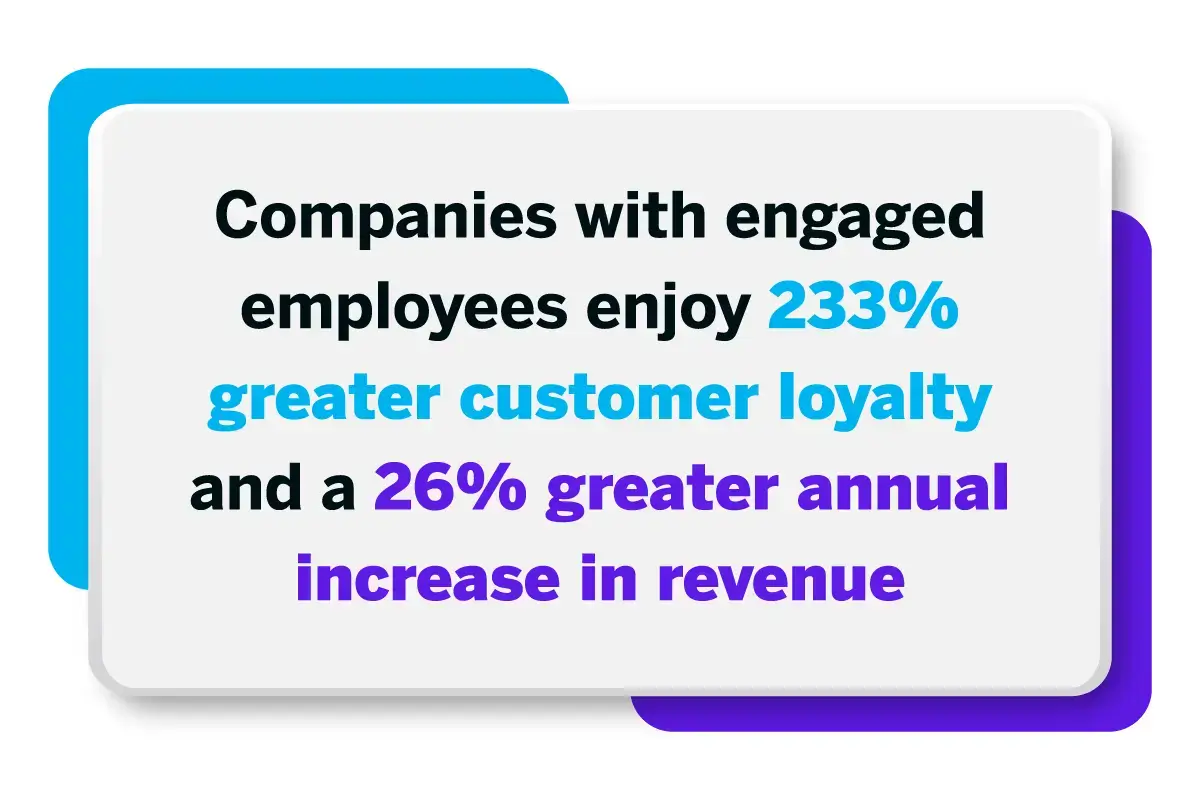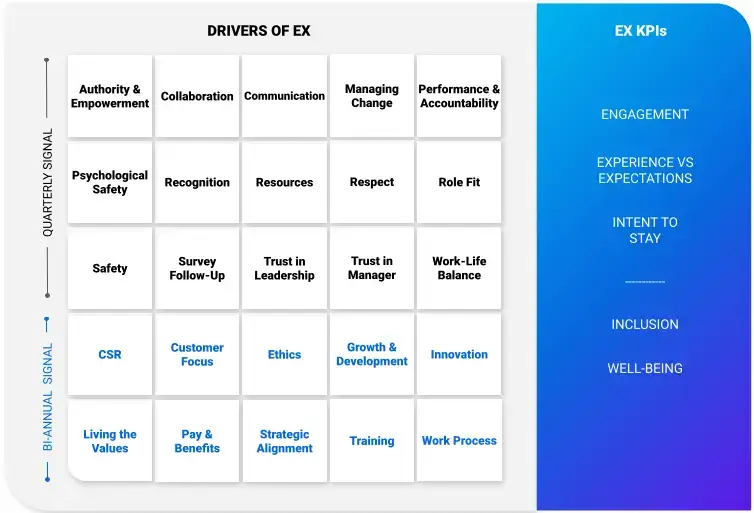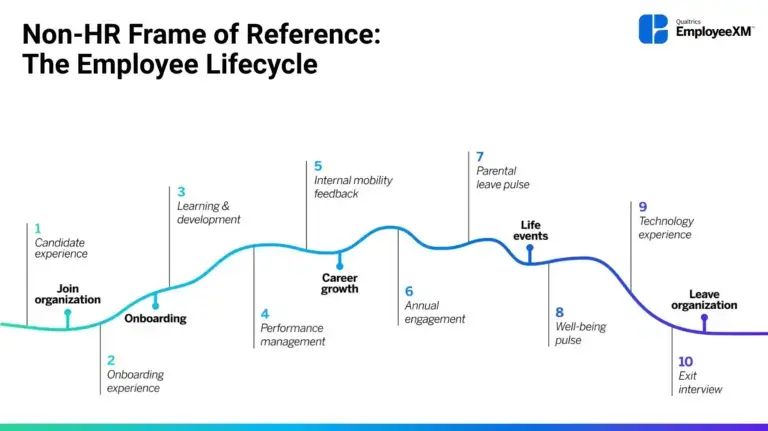Employee motivation is the amount of energy, dedication, and creativity that employees bring to work every day. When employees are motivated, they’re more likely to bring their best selves to work and achieve great things.
In this article, we’re going to cover the fundamentals of employee motivation — how it benefits organizations and what to do to cultivate it – and how it goes hand in hand with employee engagement.
What is employee motivation?
Employee motivation goes beyond how engaged your employees are. Employee motivation is the enthusiasm, energy, and drive your employees bring to their work every day.
We all know that active, committed, engaged and innovative employees can make a greater contribution to a company than tired, unimaginative, unengaged and unmotivated ones.
Of course, not all engaged employees are highly motivated, and some motivated employees are disengaged. Not all employees believe in the organization’s values or mission.
It’s these employees that organizations must focus on to boost employee motivation and drive business performance.
Free eBook: 2024 employee experience trends report
How are employee motivation and engagement linked?
Motivation explains:
- Why a person does something
- How they get started
- How they maintain momentum
- How they achieve their goals
While this sounds simple, it’s difficult for a human resources team to pin down as a single metric as people are motivated by different things.
Employee engagement is how much discretionary effort an employee gives to help their organization achieve its goals. It’s demonstrated by how employees think, feel, and act, as well as the emotional connection employees feel towards their organization, their work, and their team.
Motivation and engagement are inextricably linked. Without an effective employee engagement strategy, you would struggle to nurture teams that feel motivated to perform their best work. Engagement and motivation are complementary driving forces that initiate, drive and maintain goal-focused behaviors.
There are two kinds of motivation:
Extrinsic motivation: Employees are driven by external factors that are controlled by other people, such as team dynamics, camaraderie, pay rate, other benefits, and deadlines. Extrinsic rewards include a bonus for going the extra mile to achieve the company’s goals, or — on the other hand — a penalty for missing a deadline.
Intrinsic motivation: This is more often tied to engagement. Employees are driven by their psychological desire to do meaningful work with their fellow humans, and do it well. Intrinsic rewards include helping their team perform the best, contributing to business success, or making a difference in the community or the world.
Why is employee motivation and engagement important?
When you think about motivated employees, you probably picture a team of focused workers, who are willing to take on tasks, complete them competently and quickly, and have the energy left to tackle some more.
A motivated team will produce quality work, in a timely fashion, and will want to remain with your organization doing a job they enjoy.
Conversely, when you think of employees with low motivation, you probably picture sluggish individuals who are working slower and with less care. They may be avoiding tasks, distracting others, and quiet quitting.
An unmotivated team may produce substandard work, turn up late, and may be more likely to quit your organization for a more engaging work environment.
Highly motivated employees have a significant impact on business performance, and positively impact business outcomes. They contribute to 21% greater profitability and those teams who score in the top 20% for engagement realize a 41% reduction in absenteeism, and 59% less attrition.
What’s the return on investment (ROI) of motivated and engaged employees?

Source: Aberdeen Group
When employees work in a positive work environment, there are many benefits, financial and otherwise, that lead to a company’s success. For example, when employees are motivated and engaged, organizations experience:
Higher productivity
Motivated, engaged employees work more productively. And when employees feel they are working productively, this improves employee commitment and long term employee retention.
Less absenteeism
Absenteeism costs a company money. Motivated and engaged employees who want to come to work each day are less inclined to ‘take a sickie’ unless they are truly unwell. A way to improve employee engagement and motivation is to take care of your people’s well-being and workloads so that they do not become overworked and unmotivated. When employees are engaged and motivated, absenteeism is reduced by 41%.
Greater profitability
Research from Gallup shows that highly engaged and motivated teams show 23% greater profitability than those that don’t. Engaged and motivated employees show up every day with passion, purpose, and energy.
Higher employee retention
You’ve attracted top talent, you need to keep hold of them. When you motivate employees with extrinsic rewards and engage them with intrinsic rewards, they will likely want to stay with your organization and progress as high as they can. It’s far cheaper to retain great employees than recruit new ones.
Easier recruitment
Keep your HR professionals happy by having top talent come knocking on your door for a job. When a company gets a good reputation as a motivated workplace it will attract energetic employees whose individual efforts will benefit everyone.
Strong brand reputation
Engaged, productive, motivated employees are your best brand ambassadors. They positively influence both customer and employee relations, two factors that are essential for achieving brand equity.
How to improve employee motivation
If you’re looking to increase employee motivation, and you truly want to meet the diverse and complex needs of employees, you actually need to go beyond the KPI of engagement. You need to look at different elements of employee experience holistically from the basics of relationship to a sense of belonging. After all, we know that engaged employees can feel like they don’t belong, and that high performing employees might be looking to leave.
1. Enhance your people experience
Organizations around the world are starting to understand that to build the workforce of the future — one with high employee morale and more value-driven and flexible than ever — they have to take people’s circumstances into consideration.
This is people experience. It’s an approach that moves even beyond employee experience. Not only does it ensure that the workforce is motivated and engaged (both at work and home), but it also strengthens brand perception.
When you use frameworks like our EX25 methodology for your people analytics, it becomes much easier to identify and analyze the drivers of engagement at scale. EX25 leverages years of client research and global validation studies to deliver a proven, holistic approach to measuring and optimizing the people experience.
Employee engagement goes hand in hand with other important EX outcomes:
- How an individual employee’s experience of work measures up to their expectations
- Intent to stay (which captures whether engagement is sustainable)
- Inclusion
- Well-being
Rather than looking at engagement as a single metric, it adds new dimensions and measurements, such as inclusion and well-being, as well as the 25 most-impactful drivers for these KPIs, which include trust, safety, respect and work-life balance:

You can read more about the 25 drivers of employee engagement and how to use them here.
2. Build great manager-team relationships
This is probably the area where you can make the most impact to motivate employees. Leaders and managers who are seen as dependable, fair, honest and genuinely caring by direct reports and each team member can help drive employee engagement through interpersonal trust. Through regular surveys, our Manager Assist gives managers insights to improve employees’ experiences, to help them know how employees are doing in the moment across the most impactful engagement KPIs: well-being, inclusion, expectations vs. experiences and intent to stay.
3. Cultivate a culture of belonging
A positive, inclusive company culture is extremely important for a motivated workplace where everybody feels valued and part of the team. And belonging has emerged as the top employee experience driver linked to employee engagement, well-being, and employee motivation. Belonging not only meets your employees’ social needs, it also inspires their work and drives better business results.
4. Develop a workplace that’s diverse, equitable, and inclusive
Working with people of different races, colors, religions, sexes, national origins, ages, disabilities, and genetic information generates huge motivation in the workplace. It brings a wide variety of skills and experiences to group projects within a company to create a culture of work motivation that drives success.
5. Encourage teamwork (with a little competition thrown in)
Teamwork is the key to employee motivation. Cohesive, highly motivated teams where everybody plans, shares ideas, and solves problems are essential to achieve company goals.
6. Enable flexibility
When people have better work-life balance, they’re much more likely to go above and beyond for their organizations. According to our EX Trends 2023 research report, 63% of the respondents who rated their work-life balance highly said they were also willing to go above-and-beyond for the organizations. Whereas of those who rated their work-life balance poorly, only 29% of respondents said the same.
That’s not all — when employees have a good work-life balance, they’re 1.2x more likely to have higher well-being scores, as well as:
- 28% more likely to have their expectations exceeded at work
- 23% more likely to have higher engagement scores
- 20% more likely to feel included
- 18% more likely to continue working for their current employer for 3+ years
- 16% less likely to be at risk of burnout
7. Implement employee recognition
The number one driver of motivation in the long term is being shown appreciation for hard work. According to research, 90% of HR professionals agreed that an effective reward and recognition program helps drive business results. There are various ways you can recognize and appreciate your employees. We’ll show you how in this extensive guide.
8. Empower your employees
‘Being the best you can be’ can range from wanting to be CEO to aspiring to be the friendliest sales assistant on the shop floor. So whatever your employees’ ambitions, they’ll feel motivated to achieve them when they’re empowered to do so. You can help facilitate this by:
Giving employees autonomy
Trust your people to do their jobs without constantly checking in on them. Good managers let their team get on with the job, but are there for support if necessary.
Setting objectives with individual employees
When managers take the time to get to know their direct reports and set objectives personally with each one, that is motivating, and likely to inspire a high level of commitment and energy to the task. Give them the freedom to do the job their way, too.

Providing regular training programs
Employees are motivated by learning new things, whether technical skills for their tasks, or extra life skills training. Offering training also demonstrates to employees that management is dedicated to investing in their people, which is also motivating.
Encouraging creativity and innovation
When employees cannot express their creative ways, they get bored and unmotivated. Encourage everyone to contribute ideas when developing new products, services, logos, or branding — being heard is key to employee satisfaction.
Developing career paths
One of the biggest motivational factors for an employee is having an ambition and seeing a clear career advancement path to it. Everyone feels motivated when they have a career goal, and management must encourage ambitious employees to grow and develop with the company.
Feedback is the key to drive employee motivation and engagement
As we’ve seen above, in this competitive world, it’s essential to have an engaged, motivated workforce who are having the best people experience you can offer. And we’ve talked about the practical things you can do to improve employee motivation and engagement.
To keep your engagement program on track, you’ll need more than the annual engagement survey to listen to your employees. You can ask for employee feedback in many different ways, but one of the most effective ways to capture and act on feedback is through a continuous listening and feedback solution.
Listen to your employees across their the whole lifecycle so you can really understand experience gaps when it matters:

Qualtrics® People Engage® gives you access to tools that enable you to create and quickly distribute high-quality surveys to capture employee motivations and needs. You have:
- Engagement surveys
- Pulse surveys
- One-on-one surveys
- And much more
Predictive analytics and real-time dashboards let you measure trends and identify issues before they become problems. You’ll also be able to identify what your employees find motivating and engaging, and the obstacles holding them back from achieving their full potential.
2024 employee experience trends report